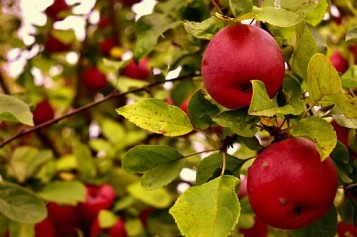
Lessons in the Orchard by Carol Ann Duffy is a poem that celebrates the vivacious side of Nature and enjoins the reader to partake in her bounteous harvest. Dealing with the themes of nature, creativity and coexistence, the poem captures the beauty of life inside a garden as the poet describes the orchard through the eyes of an artist. Lessons in the Orchard is a fine piece of ecological writing and may also be read as a commentary on artistic endeavour and the creative process.
The mellifluous lilt of this free verse poem, brought about by the well-woven imagery and deft use of poetic devices lends Lessons in the Orchard a certain dreaminess that effortlessly enchants the reader, making her aware of all the goodness that Nature has to offer.
Lessons in the Orchard | Summary
The poem “Lessons in The Orchards” by Carol Ann Duffy brilliantly captures the beauty of life that pulsates in the small space of an orchard. In this short poem, the reader is taken on a journey of life in its various aspects as it thrives in the lap of Nature, thus making it a fine piece of ecological literature and nature writing.
The poem begins with a description of a ripe apple falling from the tree it grew up on. The apple has many hues like yellow and vermillion. The imagery of a big, round, splendid apple, softly falling on the grass, instantly captures the reader’s attention to the fertility and fecundity of Mother Nature and directs one’s gaze towards the bounteous harvest that she brings forth.
The poem initially focuses on the Beauty of Bath apple. The Beauty of Bath is an attractive early-season English apple, hailing from the Victorian era. Beauty of Bath is best eaten straight out of a tree, as it doesn’t keep well for more than a day or so. Beauty of Bath would have been a welcome sight in early August, especially for the Victorian apple enthusiast. The commercial demand for this apple has been dwindling of late. One may also argue that the poet is rooting for this lesser-known fruit so as to prevent this variety from being extinct and the production stopping altogether.
Thus, we see the poet describing the ripening and falling of this apple from the tree. The poet reminisces the cultivation and gardening of the Beauty of Bath apple and relates it to various aspects of nature and numerous life forms. The focus on the apple is elevated to a larger meditation on the vibrant and life-giving force of Nature.
The poet then imagines the hands of some higher power, a woman, taking out the paint in her palette and painting the sky a cornflower blue hue with brushes and thus giving way to the beautiful blue of the sky. The poet also imagines the hands that are painting the sky to be old and to have gathered a host of experiences, both sweet and bitter. The poet then mentions various forms of life that are present as far as the eyes could see, ranging from the dragonfly that moves from flower to flower to the goldfish of the pond that lives there for its whole life. The poet sees life blooming through the window that looks into her garden and believes that life is a bowl that all living creatures are trying to fill through their very existence.
Lessons in the Orchard | Analysis
Lessons in the Orchard | Analysis, Lines 1 – 8
An apple’s soft thump on the grass, somewhen
in this place. What was it? Beauty of Bath.
What was it? Yellow, vermillion, round, big, splendid;
already escaping the edge of itself,
like the mantra of bees,
like the notes of rosemary, tarragon, thyme.
Poppies scumble their colour onto the air,
now and there, here, then and again
Lessons in the Orchard is a lovely ecocritical poem that explores the beauty of Nature and the several life-forms that contribute to the bowl of Life. The mellifluous lilt of this free verse poem, brought about by the well-woven imagery and deft use of poetic devices creates a poetic delight that readers can savour – quite like the ripe Beauty of Bath that falls softly on the grass in the opening of the poem. The poem was written by Duffy to celebrate the 25th Anniversary of the Charleston festival
The enjambment in the very first line immediately draws the reader’s attention to the object of the poem in the second line – the ripe Beauty of Bath apple that has fallen on the grass. Duffy’s poems are known for their ability to command and direct the gaze of the reader to the object it intends to highlight, as is demonstrated by the strategic use of enjambment in the aforementioned instance. This is also seen in the use of repetition of the question “ What was it ?” in lines 2 and 3. Further, the description of the apple with a salvo of adjectives (Yellow, vermillion, round, big, splendid) in the third line shows the use of deft brushstrokes to paint the beauty of the Beauty of Bath.
The apple is so ripe that it is ready to leave the branch, already escaping the edge of itself. A simile is used to liken its productive exuberance to the mantra of bees that leave their honeycomb to frequent the flowers and produce nectar. Intense floral imagery is conjured to liken Nature’s richness to the aroma of rosemary, tarragon, and thyme. Note the pun on the word “notes” in line 6. The mantra (a sacred chant) of the bees hit the notes in the musical sense while the aroma of the flowers forms pleasant notes, thus exhibiting Duffy’s craft in weaving together the auditory and the olfactory richness of Nature through a single word.
Further, the imagery of the poppy flowers and the way they scatter their colours in the form of pollen, all over the place betrays a sense of uninhibited profusion that almost dulls the senses. Scumbling is a technique used in painting to visually soften or lighten areas on the canvas. Not only is the use of this term highly apt in the case of the poppy plant, whose petals have a softening effect on sunlight that falls on it, it is also connotative of the somniferous nature of the plant that is a source of opioids. The dulling of light (and senses) is also achieved through the use of internal rhyme in the 8th line “now and there, here, then and again.”
Lessons in the Orchard | Analysis, Lines 1 – 8
Alive-alive-oh,
the heart’s impulse to cherish; thus,
a woman petalling paint onto a plate –
cornflower blue –
as the years pressed out her own violet ghost;
that slow brush of vanishing cloud on the sky.
And the dragonfly’s talent for turquoise.
And the goldfish art of the pond.
And the open windows calling the garden in.
This bowl, life, that we fill and fill.
In this stanza, the poet says that the heart just wants to cherish the fact that it is alive and breathing. The theme of painting life into the orchard is pursued in this stanza wherein the poet describes the hands of a higher power engaged in creating the beauty of the picture-perfect orchard.
The poet imagines the hands of some higher power, a woman, taking out the paint in her palette and painting the sky a cornflower blue hue with brushes and thus giving way to the beautiful blue of the sky. Notice the use of caesura in Line 10 which provides a break in the pace of the poem and directs the reader’s gaze to the higher feminine power who has been painting life into existence: a woman petaling paint onto a plate. The alliteration employed in this line also lends additional emphasis to the creative and life-giving action of the higher power.
The poet also imagines the hands that are painting the sky to be old and that they must have undergone many hardships in the course of their life that turned her soul. The creative process has extracted its fair share of demands on the creator. This also brings to the fore the figure of the artist and the Lessons in the Orchard may then also be read as a commentary on the creative process and the various aspects that the act of creating – both life and art- entails. This is further corroborated by the mention of the dragonfly’s “talent” for turquoise and the goldfish’s “art” of the pond. The use of anaphora in lines 15-17 ( And the dragonfly’s talent … And the goldfish art…And the open windows) reinforces the action of filling the bowl of Life by its various actors.
The poet then mentions various forms of life that are present as far as the eyes can see, like the way the dragonfly moves from flower to flower and the goldfish in the pond that is present lives there for its whole life. The poet believes that life is a bowl that everyone, be it people or plants, fruits or flowers, insects or fishes, are all trying to fill. Notice Duffy’s brilliant use of “l” sounds in the last line of the poem. Known as liquids, the l sound is used to mimic the fluid forces that fill the bowl of life, thus demonstrating the poet’s masterful craft in weaving in the threads of form and content:
This bowl, life, that we fill and fill.
The various life-forms that populate this poem – the apples, plants like poppy, rosemary and tarragon, herbs such as thyme and creatures like the dragonfly and goldfish – all have received the blessing from Mother Nature and call the Orchard their home. The relentless striving of Life to proliferate, prosper and “reach the edge of itself” is a profound lesson the poet sees unfold before her eyes amidst the orchard – a fragment of the bowl of Life that all her fellow creatures strive to fill and fill.
Lessons in the Orchard | About the Author
Born on the 23rd of December, 1955 Carol Ann Duffy is a British poet and playwright. She is also a professor of contemporary poetry at Manchester University. She is the first woman, the first Scottish-born poet and the first known LGBT poet to hold the position of Poet Laureate.
Her writings beautifully explain the marvels of the world. Myth and fairy-tale are vital to her imagining of the world but they are given contemporary voices of her poems. Her poems are often written in a monologue. The combination of tenderness and toughness, humour and lyricism, unconventional attitudes and conventional forms, has won her a very wide audience of readers and listeners. Like “Lessons in the Orchard”, Carol Ann Duffy’s poem “ The Dolphins” is a brilliant piece of ecocritical writing, the analysis of which may be read here.


